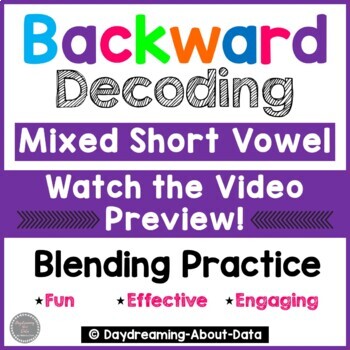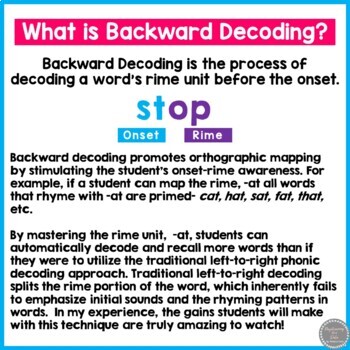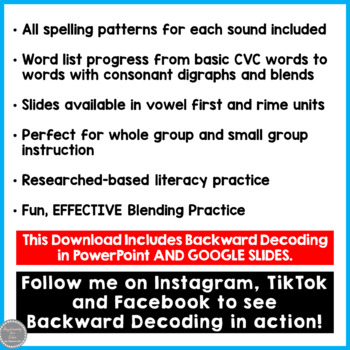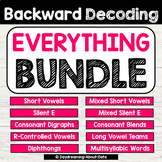Short Vowel Blending and Decoding | Backward Decoding
- Zip
What educators are saying
Also included in
- Are you looking for a way to improve your phonics instruction and your students' automaticity and reading fluency? Backward Decoding is a highly effective and engaging way for your students to practice and improve their letter sound automaticity, blending skills, word recognition and reading fluencyPrice $146.36Original Price $229.32Save $82.96
Description
This resource includes Backward Blending in POWERPOINT AND Google Slides™!
Are you looking for a highly effective way to practice and improve your students' short vowel decoding and blending skills? Backward decoding is the perfect addition to any literacy block! With repetitive and consistent use, backward decoding will skyrocket your students' reading progress! Perfect for whole group and small group instruction, these digital slides include 1,000's of letter animations and are incredibly versatile, EFFECTIVE and ENGAGING for students!
***Be sure to watch the video preview to see backward decoding in action in my classroom!
This resource includes:
- 66 SHORT Vowel Backward Decoding Slides with animation (In PowerPoint & Google Slides™)
- Slides are organized by vowel sound (vowel by itself) and rime units (See video preview for an example of both)
- Word lists progress from basic CVC words to words containing consonant blends and digraphs
- All spelling patterns for ALL 5 Short Vowels included
You May Also Like Backward Decoding:
OR Maybe...
Be the first to know about my new discounts, freebies and product launches:
CLICK HERE to receive updates on new products, sales, and freebies! I post at least 1 freebie every month AND I discount ALL new products up to 50% off for the first 24 hours. It really does pay to follow me!
*****************************************************************************
Customer Tip:
Don’t forget that leaving feedback earns you points towards FREE TPT purchases.
I truly do value your feedback!
⭐️ What are TpT Credits?
You can gain TpT credits by going back and leaving feedback on any purchases that you have made. The credits build up and then you can use them towards future purchases! The credits REALLY do add up!
I love to see my resources in action! Find me @daydreamingaboutdata on Instagram and Facebook!
If you have any questions, please feel free to email me at daydreamingaboutdata@gmail.com
I appreciate YOU!!
Sincerely,
Rebecca @ Daydreaming-About-Data






